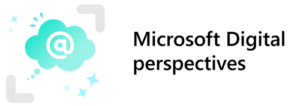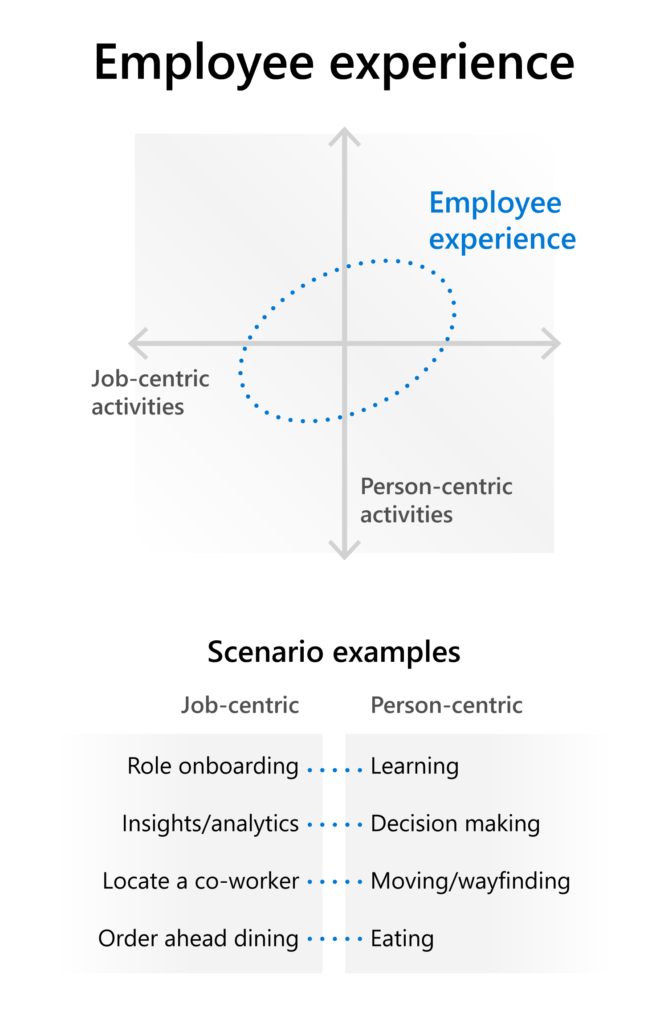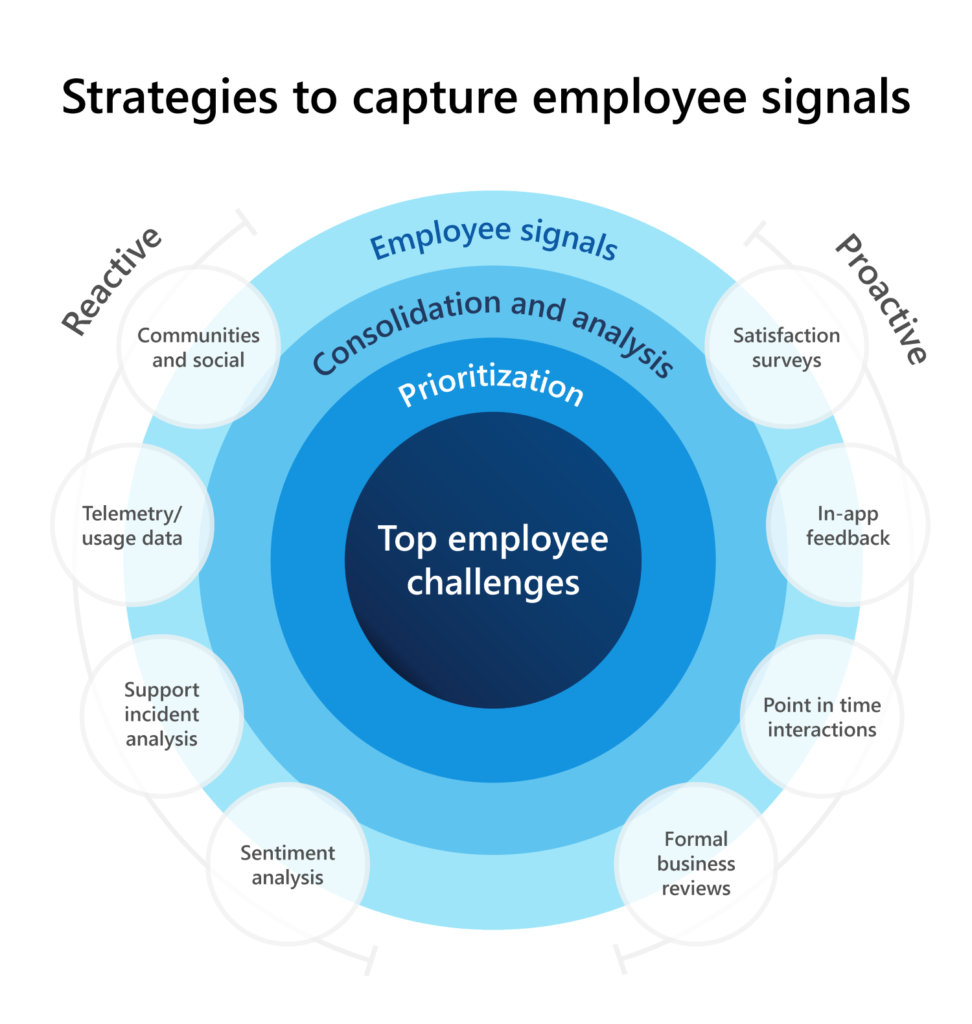 Digital transformation is an important topic for most organizations, and we’re often asked to share the specific steps that we have taken to transform the Microsoft employee experience in Microsoft Digital Employee Experience, the organization that powers, protects, and transforms Microsoft. This series highlights how we accomplished this internally across two key pillars of the digital transformation journey: empowering employees and transforming operations.
Digital transformation is an important topic for most organizations, and we’re often asked to share the specific steps that we have taken to transform the Microsoft employee experience in Microsoft Digital Employee Experience, the organization that powers, protects, and transforms Microsoft. This series highlights how we accomplished this internally across two key pillars of the digital transformation journey: empowering employees and transforming operations.
At the heart of this transformation is an obsession with the Microsoft employee experience.

In our view, the employee experience is a nexus where personal needs and employee needs are both met. When this is great, employees are highly satisfied with the experience and are very productive. The activities that hit the mark on this range from generic experiences applicable to all employees—like finding available meeting rooms, searching for internal information, or understanding their benefits—to more role-specific experiences, like manager insights to support their teams or loading sales data into a CRM system.
The employee experience isn’t limited to day-to-day activities; it’s considered throughout the employee’s lifecycle: from onboarding and internal role changes through to retirement.
A keystone to empowering employees in how they do their jobs is to understand what employees need by identifying their top challenges and successfully meeting their needs. Before our digital transformation advanced in earnest, we would make changes without fully understanding whether they met our employees’ needs and we often wouldn’t do enough to help them adapt to the changes. This was met with limited success.
Getting to a better place required a change in mindset, as shared by Microsoft CEO Satya Nadella: “As a culture, we are moving from a group of people who know it all to a group of people who want to learn it all.” To learn it all, we began establishing listening mechanisms to learn from our employees, recognizing that as technologies advance, employee expectations of their devices and experiences advance as well, with increasing expectations that both work seamlessly to enable them to do their best work.
[Read the second blog in the series on how Microsoft is transforming the company’s employee experience by listening to employee signals. Read the third blog in the series on how investment prioritization is driving the transformation of Microsoft’s employee experience. Learn how Microsoft Digital is reinventing the employee experience at Microsoft.]
Strategies for capturing employee signals
When we started down the path of understanding our employees’ needs, we realized we had to develop a comprehensive set of employee signals first. To us, signals are indicators of employee satisfaction with the tool or service. Examples of signal sources include employee survey data, direct interviews with employees or leaders, and product usage data (we’ll explore these sources in greater detail in a moment). Our strategy relied on some signal sources that were already in place, but to meet our goals, we expanded our sources to ensure we listened to all employees.
Being a global enterprise, we had to consider our many cohorts of employees—all countries and regions; all roles, including individual contributors, managers, and leaders; the locations of all workers, including remote, in-office, and hybrid. We needed to make sure we didn’t exclude picking up signals from any group.

We used existing data trends to understand our employees without disrupting them (such as telemetry and usage data). This informed an initial indication of where pain points or adoption blockers might be.
We also needed to hear directly from our employees to confirm or alter those initial impressions, so we established several proactive mechanisms to gather feedback. The following diagram shows an example of some of the signal types used to gather this data. We will explore some of those listening signals more here.
Proactive employee signals
We gather proactive signals preemptively, and they’re critical in helping us understand what our employees think. Here are several ways we proactively gather those signals and some of the expected outcomes we have for them:
- Satisfaction surveys: Our approach to understanding employee satisfaction has evolved through the years, but surveys remain a foundational feedback source. We have many different teams at Microsoft who want to survey our employees, so we must rationalize how frequently we seek feedback, be strategic in asking the right questions, and adjust based on the groups we survey. If we ask a question, it needs to be worth the employee’s time to answer and valuable enough to act on based on the results. Some of our established surveys have a brand and are recognizable to our employee communities. In many cases, our strategy is to use these existing surveys by either extending them with customized questions or utilizing the data they gather. Once results are finalized, we analyze the data and consider trends against previous rounds of the same data.
- In-app feedback: This type of proactive signal is meant to meet employees where they are and allows them to provide feedback in real time as they’re experiencing a problem or bug. In-app feedback usually addresses feature-specific pain points, and it always requires people with specific expertise on the platform to help triage the feedback.
- Point-in-time interactions: For deeper qualitative insights, we use point-in-time interactions. This includes speaking directly to employees about their experiences. We do this through voluntary employee insider programs or by using our internal research teams, who are experts at gathering insights on the design of new solutions and feedback on employee workflows. Employees chosen for these programs often include our heaviest users or those whose job it is to understand the needs of different employee groups (such as sellers and finance).
- Formal business reviews: Each organization at Microsoft operates on a unique cadence and rhythm with different requirements and needs. These discussions surface important organizationally specific needs but can also help surface tool or process-related pain points correlating to the overall Microsoft employee experience too. We align representatives from our Microsoft Digital business to these areas and business units to ensure that we capture those insights.
Reactive employee signals
Reactive signals come from employees sharing their feedback and needs either directly or indirectly through their interactions with tools, and are a source of direct evidence of how they actually use a product or service:
- Communities and social channels for sentiment analysis: Sentiment algorithms to monitor key employee communities are a great way to identify trends, and we consistently capture those anonymized sentiments. Sentiment trends allow us to examine known, acute issues and look for new emerging themes. We also can use these engines to ask questions directly and get real-time feedback in an informal way that doesn’t feel disruptive to the employee.
- Telemetry and usage data: Anonymized usage data enables tracking an employee’s experience within a tool or app, which enables us to gauge adoption or success metrics for a given tool or scenario. For example, when we deployed Microsoft Teams internally, we evaluated several usage indicators to determine if our adoption goals were on track, including a gradual decline trend in email usage among employees as well as increase in Microsoft Teams functionality like chat, file share, and more.
- Support incident analysis: Our support team tags and categorizes each support incident by type, solution, and employee group (such as engineer, sales, finance, and so on) to categorize issues and themes by key demographics. We use these insights to validate the qualitative feedback we receive through proactive and reactive channels.
Connecting what employees said with how employees acted
By evaluating reactive and proactive signals, we can connect what employees say with how employees act. Consider this example. Last year, more than 40 percent of support calls for our primary sales system were related to access or login issues. This amount of volume alone had significant productivity, satisfaction, and operating cost implications. And the volume of these reported issues was growing.
At first glance, it may seem that this was a simple access issue. But it was through analysis of additional proactive and reactive signals—like business reviews and social channels—that we saw the challenge was beyond just these access issues. It wasn’t just a technical issue; it really was a training issue. Without that deeper analysis, we would have addressed the wrong problem.
Building on the foundation
In the subsequent articles that comprise this series, we will share the steps we took to change our approach by listening to our employees and demonstrating how we addressed some of their biggest pain points. Here’s what you can expect in each article:
- Analyzing and prioritizing employee signals: Understanding trends and themes across data sources and tips for data-driven prioritization strategies.
- Influencing to prioritize the change: Connecting the story in the change management strategy to the original employee signals to drive adoption velocity.
Digital transformation at Microsoft will continue as our business evolves and emerging technologies like AI and machine learning offer new avenues to accelerate that change. What won’t change is our foundational commitment to learn, grow, and obsess about not only our customers but also our employees. We’re excited to show you how.

- Read the second blog in the series on how Microsoft is transforming the company’s employee experience by listening to employee signals.
- Read the third blog in the series on how investment prioritization is driving the transformation of Microsoft’s employee experience.
- Learn how Microsoft Digital is reinventing the employee experience at Microsoft.




